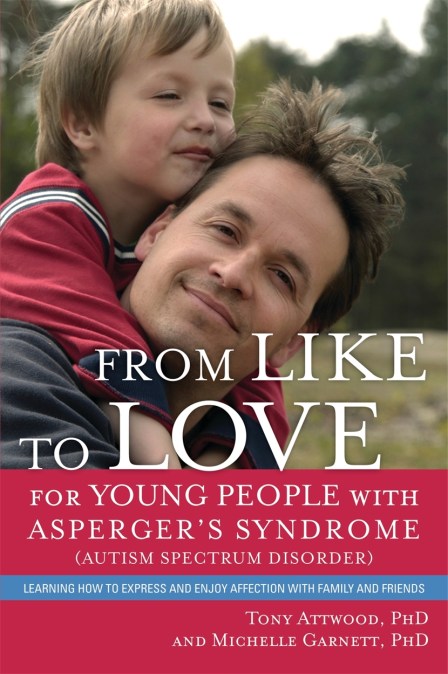From Like to Love for Young People with Asperger’s Syndrome (Autism Spectrum Disorder)
If your child rarely shows you that he or she loves you, it can be profoundly distressing. This is the experience of many parents of children with an autism spectrum disorder (ASD), and most fear that it reflects the truth. In fact the truth has generally more to do with the difficulty that young people with an ASD have in communicating like or love for someone physically and verbally. They may not know how to go about expressing themselves in these ways, or understand that family members and friends can find the absence of demonstrative affection upsetting.
This book, by world leading experts Tony Attwood and Michelle Garnett, addresses this issue in practical terms. They provide carefully designed activities for parents to work through with their children to help them to understand and express affection. Their child will learn to identify his or her own and others’ comfort and enjoyment range for gestures, actions and words of affection and the different ways to express feelings for someone, appropriate to each relationship and situation. The activities are simple, straightforward, and very carefully structured, so that they can be undertaken at the pace that works for the individual family. The book also guides the adult through the challenges faced by the child, leading to greater understanding and confidence in their relationship with their child, and increased ability to nurture the child’s ability to form engaged relationships and friendships with others.
Readers of Tony Attwood’s previous books will recognise his warm, positive and empowering approach. The book will be a transformative resource for parents and family worried about their child’s emotional life.
This book, by world leading experts Tony Attwood and Michelle Garnett, addresses this issue in practical terms. They provide carefully designed activities for parents to work through with their children to help them to understand and express affection. Their child will learn to identify his or her own and others’ comfort and enjoyment range for gestures, actions and words of affection and the different ways to express feelings for someone, appropriate to each relationship and situation. The activities are simple, straightforward, and very carefully structured, so that they can be undertaken at the pace that works for the individual family. The book also guides the adult through the challenges faced by the child, leading to greater understanding and confidence in their relationship with their child, and increased ability to nurture the child’s ability to form engaged relationships and friendships with others.
Readers of Tony Attwood’s previous books will recognise his warm, positive and empowering approach. The book will be a transformative resource for parents and family worried about their child’s emotional life.
Newsletter Signup
By clicking ‘Sign Up,’ I acknowledge that I have read and agree to Hachette Book Group’s Privacy Policy and Terms of Use
Reviews
This book is clear, concise and practical... in other words, it is a parent's dream. The book gives us usable information in a blessedly short book. I recommend this book for parents, caregivers, and teachers. Tony is one of the world's most empathic and creative experts on those individuals on the higher end of the autism spectrum. Michelle's work is already known in Australia, and she is a rising global star.
To me as a parent, this book is a godsend – clear, logical, easy to read and above all useful!
It addresses a fundamental problem which is of concern to many parents – How can we, in practical terms, help our children learn to express and communicate their emotions, especially when they reach their teenage years and beyond?
Grounded on a solid base of expertise, experience and compassionate understanding, the authors offer a clear, insightful structured solution. The sessions described in the book are easy to understand and equally easy to implement. They will go a long way to help our young people with Asperger's syndrome (autism spectrum disorder) understand the “rules of the game” and thereby achieve a more level playing field.
Some of the most basic factors determining an individual's placement on the autism spectrum are difficulty in identifying and correctly responding to cues in social situations, along with struggles with reading and expressing emotion. These are also among the most challenging aspects of life to teach a person. Coauthors Attwood (The Complete Guide to Asperger's Syndrome; Asperger's Syndrome: A Guide for Parents and Professionals) and Garnett (founder & director, Minds & Hearts) are both clinical psychologists based in Australia with decades of experience with people on the spectrum. Here, they showcase a series of activities and worksheets that parents can use to assist their children in understanding and expressing affection. VERDICT Through storytelling, the authors describe social situations to depict different phases of affection. This easy-to-read book is good for use with a wide range of individuals and is recommended for parents and professionals alike.

